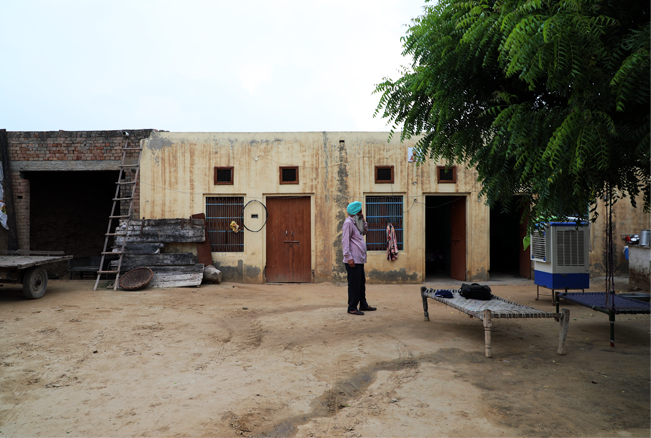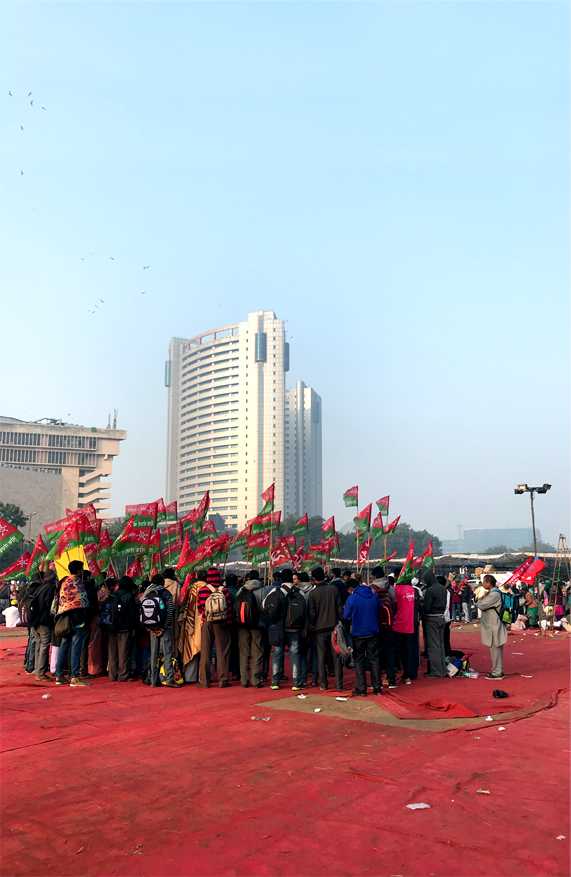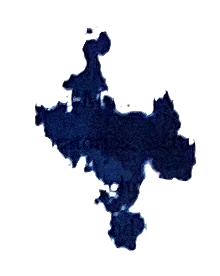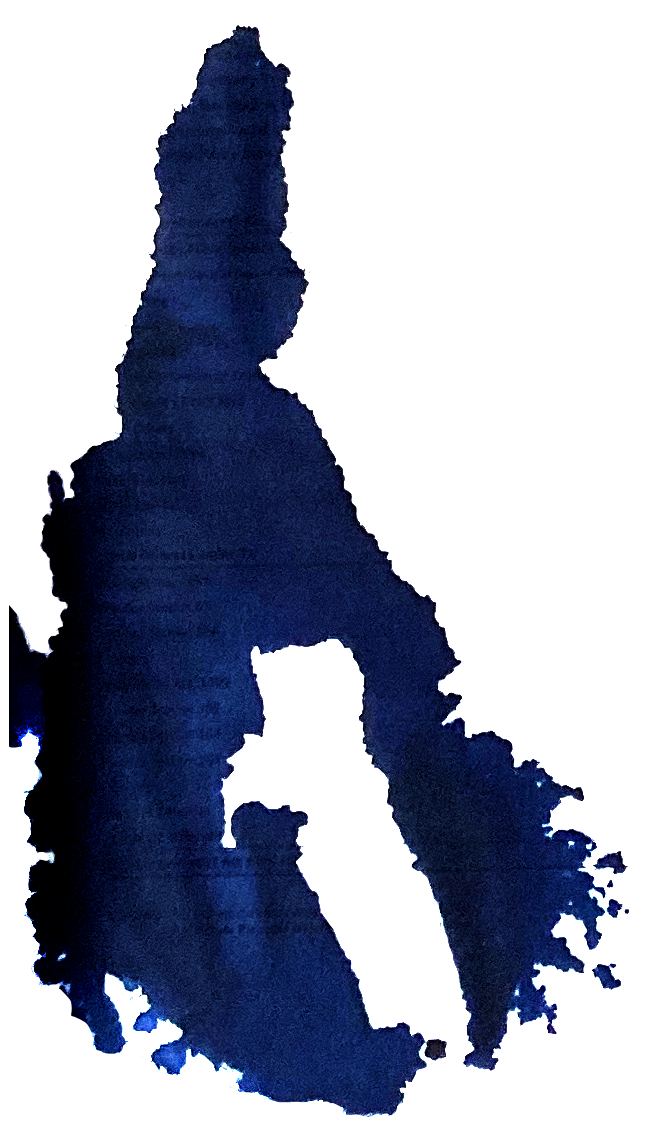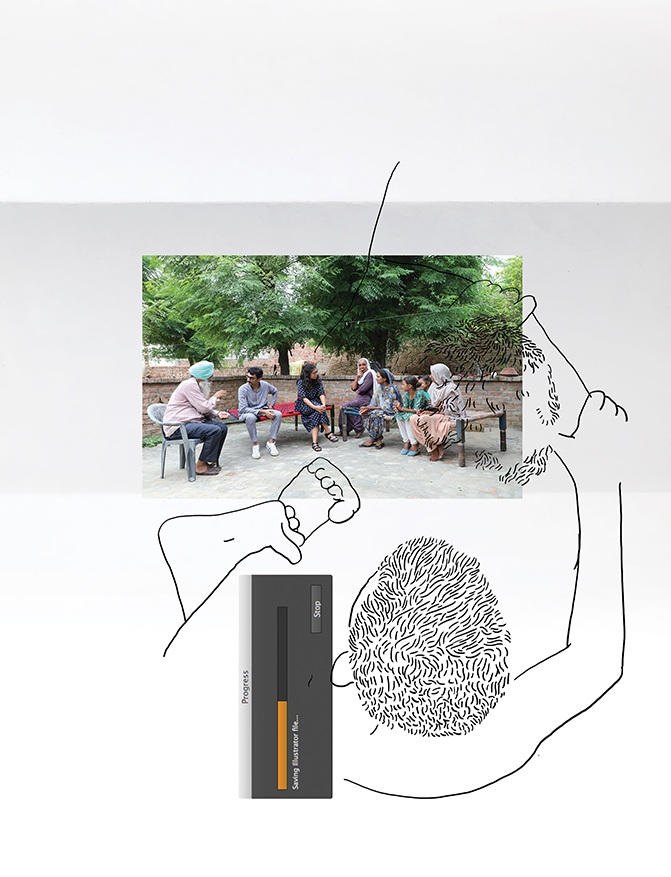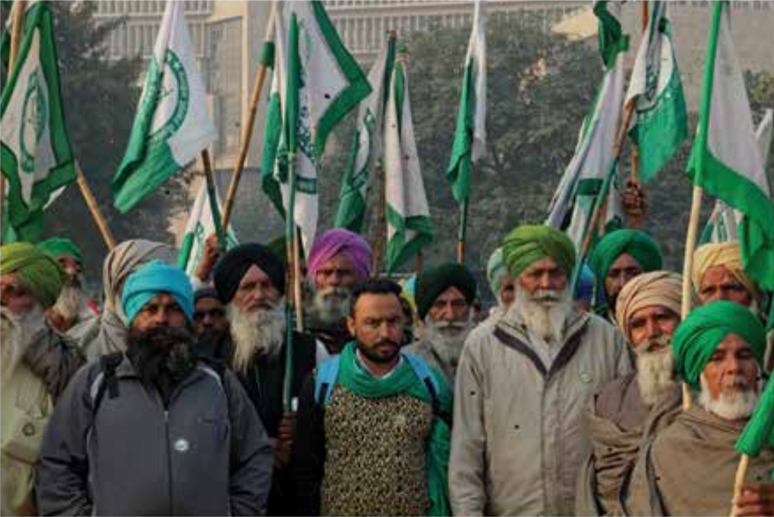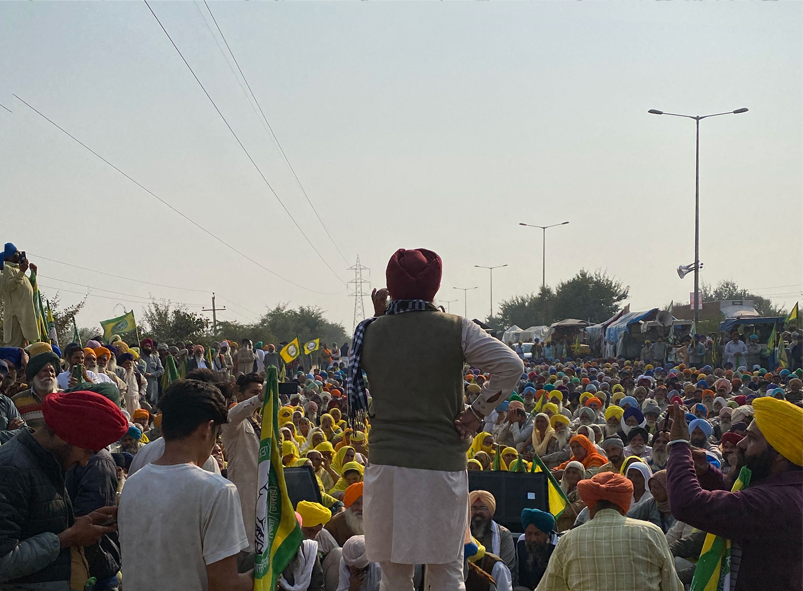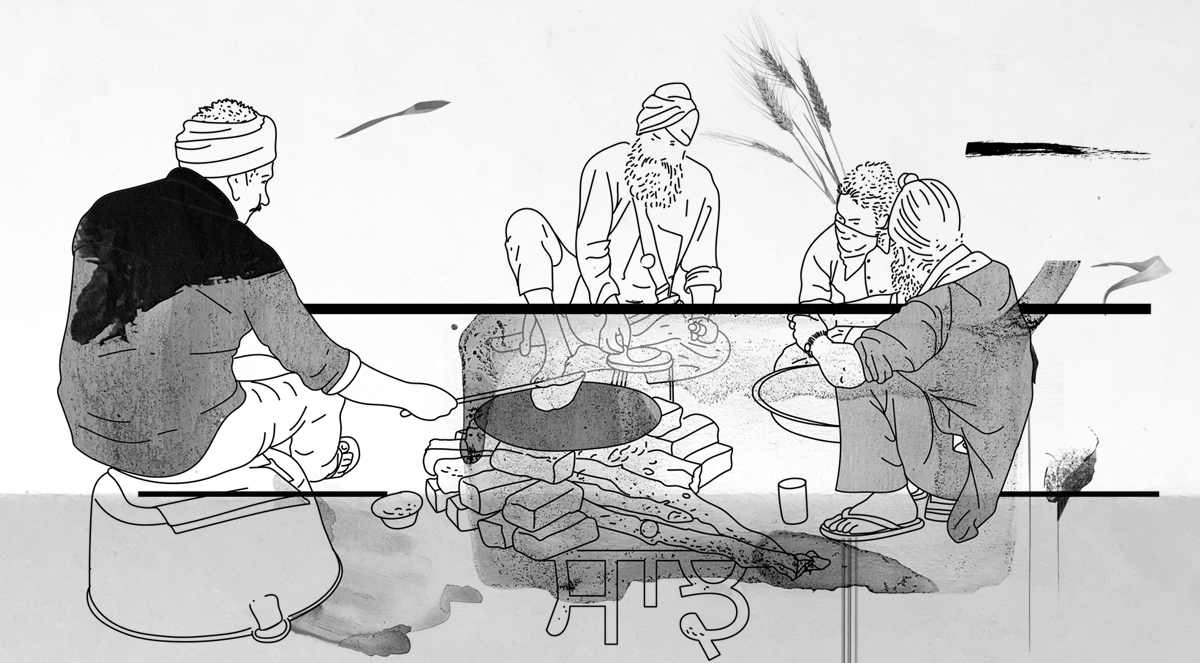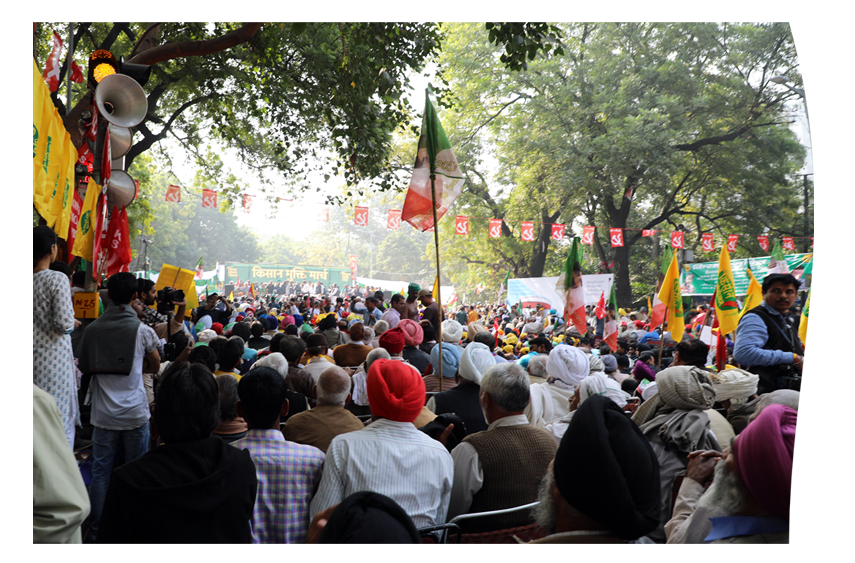
"Farmer’s fate: a life that is suspended in limbo"
Farmer is a Wrestler: A Lexicon of Distress, 2021 is a website-specific digital artwork acknowledging the farmers' movement in India. This 7th iteration of “Farmer is a Wrestler” is not a site of protest, but a safe space to inform and comprehend the situation of Indian farmers who are questioning their rights, existence, and daily survival in a world that is increasingly authoritarian and privatized.
The artist-duo attempts to comprehend the intricate details of the lives, trials, and tribulations of the agricultural community by drawing parallels between a farmer and a wrestler by highlighting this precarious aspect of the farmer’s fate.
A Lexicon of Distress, 2021, Thukral & Tagra have created a digital lexicon of terms that are integral to understanding the characteristics of the Indian farming community. As the viewer scrolls through the lexicon, images, and illustrations depicting the ever-shifting landscape of farming float in the suspended space, creating a tiered, capricious and unstable environment.
The artists’ implicit response to the current socio-political circumstances exhibits a perspective to underline issues that can help raise public awareness through an empathetic approach.
Agriculture subsidies are intended to support farmers and farming businesses. However, the critics believe that such subsidies can have a detrimental impact on natural resources. For instance, irrigation enabled by subsidised electricity has led to depletion of groundwater in the states of Haryana and Punjab.¹ (Agarwal, 2011, p.10)
The role of the private sector is becoming increasingly prominent in the Indian agricultural services, which has resulted in higher efficiency on one hand but also created a conflict of interest between maximizing profits for companies versus the welfare of farmers.
To be legally defined as a farmer in India, and benefit from associated rights, a person must own land. However 56.4% of the rural population – or over 100 million people – do not own any agricultural land ² (Socio-Economic Caste Census (SECC, 2011). The situation is worse for women who only own 13% of India’s farmland, despite providing 65-70% of its labour, according to an Oxfam report of 2013.
To help stabilise farming incomes, the Government of India introduced an insurance scheme in 2016 called Pradhan Mantri Fasal Bima Yojana (PMFBY), payable in the event of crop failure. However, the scheme has faced much criticism as it has allegedly made the insurance companies very rich whilst not providing the required support to farmers ³(Bhatnagar, The Wire, 2018).
Microfinance institutions disseminate small credit at a cheaper rate to strengthen the capacity of the poor and thereby alleviate abject poverty. However, farmers pay interest rates as high as 24% - 60% ⁴(Thukral and Tagra studio, 2018), leading to rural distress and suicides. Along with private moneylenders, the organized microfinance units have emerged as the horror in the lives of the farming community. To recover the loans, these institutions often use wrong practices like criminal intimidation, harassment, and labour without pay ⁵(Reddy, 2018).
The Union Budget is India’s national budget, which in 2018 included a pledge to double farmers’ incomes by 2022. However, the 2021-22 Budget saw an increase of only 5% in the allotted budget for the Department of Agriculture, Cooperation and Farmers, which is effectively a decline of 8% from the 2020-21 Budget Estimates announced last year ⁶(Kapil, Down to Earth, 2021).
Although all political parties acknowledge the dire situation faced by the agricultural economy, none have yet found a solution to the complex issues. All parties have attempted to secure the farming vote by making financial promises, but whether they have been fulfilled, is questionable.
The Agricultural Produce Marketing Committee (APMC) is a marketing board established by the Government of India to bypass middlemen who take a large profit. However, it has been alleged that this initiative is often abused by cartels and those in power with farmers income becoming unremunerated ⁷(Sharma, Ground Reality, 2018).
More than half of India’s population is rural, meaning that they have the majority vote. It has been opined that the political parties view them as vote banks and make manifesto pledges to support agriculture communities in the run up to elections in order to be elected, but often leaving them disappointed.
Contract farming means that farmers pre-agree a price at which to sell their produce with the Marketing Agency, rather than be exposed to the volatility of the market. However, many farmers lack the education to fully understand the contracts, which often fall through due to being informal and verbal ⁸(Sharma, Ideas for India, 2018).
Research indicates that rural India lacks a Legal Aid infrastructure, which means that laws and policies intended to help farmers often have little or no impact on their livelihood.
In 1991, India opened up its international trade by reducing tax on imports, exposing Indian farmers to global price volatility.
Review of research literature indicates that the unprecedented crisis facing the Indian agriculture sector is a result of numerous policy decisions taken by the current authority in power.
Most recently, in September 2020, the government passed three agricultural reforms purportedly to grant farmers freedom of trade. However, these Acts instigated nationwide protests by the farmers who believe that the proposed deregulation of agricultural markets will benefit only the private corporations, further worsen the prevailing farmer crisis, and widen the inequalities in this sector ⁹(BBC, 2020).
Commission agents, or ‘arthiyas’ have acted as the middlemen between farmers and buyers for many generations. Despite the intentions of the Agricultural Produce Marketing Committees (APMCs), there are more than 21,000 arthiyas in the state of Punjab alone, each managing hundreds of farmers, and some believe, exploiting them for a significant profit.
Political insurgency or unrest restricts the movement of people and farming activities.
On 8 November 2016, India’s Prime Minister announced that the country’s 500 and 1000 rupee notes would no longer be legal currency, with only four-hours notice. Although the stated intention was to limit corruption, the effect on the cash-based farming communities was severe.¹⁰(Sumathy and Savitha, 2017, p. 35-38).
Following independence in 1947, the Government of India divided agricultural land between farmers. However, some claim that the land was unfairly distributed as a relatively wealthy 4.9% of the agricultural community currently owns 32% of the land.¹¹(Chaturvedi, The Wire, 2016)
Continuous subdivision of farming lands due to government policies or Indian inheritance laws (wherein land is disbursed proportionately among sons), the vast majority of farmers in India do not have enough land for sustainable production.
In 2019, the Government of India agreed to allocate 0.2% of its national budget to write-off loans to farmers in the event of crop failures ¹²(The Economic Times, 2018). This is not enough to sustain the total number of farmers who need to benefit from the initiative: two-thirds will not benefit at all.However, in the long run it has a negative impact on farmer interests as it does not address the underlying problems existing in the agri-sector of decreasing farm income,debt trap or crop failures.
Nationalised banks offer loans but require collateral security, which means that those without equivalent value property, assets or equipment have to resort to moneylenders.
In an attempt to stabilise prices, the Government of India sets minimum support prices (MSP) for procuring farming produce. A review of data indicates that this strategy has proven to be ineffective as only 6% of farmers benefit from MSP ¹³ (NITI Aayog 2016, p.10).
However, this situation is subject to change as the new farm acts passed by the government in September 2020 do not have any provision for MSP nor for procurement of foodgrains by the Government. Farmer unions have heavily criticized these acts as they believe that without these provisions farmers will be susceptible to price fluctuations, and open to exploitation by private corporations.
Furthemore, according to the 2021-22 Union Budget, the amount allotted under two schemes that ensure implementation of MSP, namely Market Intervention Scheme and Price Support Scheme (MIS-PSS) and Pradhan Mantri Annadata Aay Sanrakshan Yojna (PM-AASHA), saw a sharp decline by 25% and 26%, respectively compared to last year.
Launched by the Indian National Bank for Agriculture and Rural Development, and the Reserve Bank of India, the Government of India introduced the Kisan Credit Card (KCC) to provide easy business credit for farmers. However, as of 2017 only 10.5% of agricultural households have a valid KCC. ¹⁴(NABARD All India Rural Financial Inclusion Survey (NAFIS) in 2016-17, pp. 72-74).

Farmers often need credit at very short notice during the farming season and so resort to borrowing from informal sources.
Sponsored by the Government of India, the Public Distribution System includes the chain of suppliers trusted to distribute basic food to those in most need at subsidised prices. However, some argue that this is to the detriment of the farmers producing the food. Farmers are not able to fetch their sale proceeds in time, therefore, selling their proceeds at a lower rate in the open market ¹⁵(Bhattacharya, Falcao & Puri, 2017, The World Bank, p. 45-47)
India is a multicultural and multilingual country. Religious beliefs and cultural systems play an important role in rural agricultural communities in deciding access to resources, which leads to discrimination of certain communities.
A caste system is a social structure that divides a community into class categories. The traditional Indian caste system continues as a socio-economic hierarchy ¹⁶(Agriculture Census 2015-16, p. 8-9), with majority of the land being owned by authoritarian upper caste communities.
Review of literature indicates that women do not receive fair treatment in any aspect of the farming system in India. Poor social security by the virtue of their gender, legislation, and delays in support from the state worsen their situation. For instance, while over 65% of women working in India depend on agriculture, they own less than 13% of the land. Additionally, merely 7.5% of women participate in decision-making against 92.5% of men even as the burden of household chores falls to them ¹⁷(Information Docket, Dilli Chalo, 2018). Furthermore, the high rate of suicides by men implies that women are left with their debts, adding to their economic disparity.
Those living in poverty in rural India are amongst the least educated, which means they are not equipped to make the best of, or improve, their circumstances.
Over 85% of farmers in India own less than two hectares of land (0.02 km2), which is not enough to live on even with the most successful harvests.
Nearly 100 million farming households struggle because their essential household expenditure is greater than their net monthly income.¹⁸ (Census Data 2015-16)
Those with less than two hectares of land, which is 85% of the farming population, earn only 9% of the country’s farming income. ¹⁹(Indira Gandhi Institute of Development Research (IGIDR).
Every 1 in 3 Farmers in Punjab is below the poverty line ²⁰(Sharma, Ground Reality, 2018). Most available jobs in agriculture are associated with low and unstable incomes, gender inequality in pay, rural-urban migration, poor safety, and health conditions and opportunities, and limited social protection.
The average income growth of a farming family in 2011-2016, was only 0.44% implying that stagnant income for farmers against increased expenditure, while their income mirrors inflation every month in the same period with supplementing food inflation at 2.8% ²¹(NITI Aayog, 2018). In around half of India, the income of an average farming family of five is only INR 20,000 a year, which is only INR 1,700 a month for the entire family ²²(Economic Survey of India, 2016, p.73).
The situation is becoming increasingly dire as unsustainable landholdings, water shortage, loans at high interest rates, inaccessibility to modern technologies are making farmers susceptible to weather shocks and market volatility. People working in the farming industries are at a higher risk of suicide than average, with more than 300,000 farmers having committed suicide between 1995 and 2015. In 2019 alone, the total number of farmers / farm labourers who died by suicide was 10,281, according to the National Crime Records Bureau (NCRB).
As agriculture is a seasonal employer, many men are forced to leave their wives to run the family farms for up to a year at a time in search of paid work in cities. However, as the employment market is saturated in major cities, many are open to exploitation and often live and work in terrible conditions. Those that manage to find paid work can keep their farms running as a source of food for their families.
The population of India is projected to reach 1.52 billion by 2036, according to a July 2020 report of the technical group on population projections, which puts a huge pressure on food production, land and resources. ²³(Agarwal, The Wire, 2020)
The Great Depression from 1929-39 was the worst economic downturn in the history of the industrialised world. It had a global impact, including India shifting from being an agriculture-based economy. During this time many farmers went bankrupt and lost their farms to high rents.
Rather than be an ecological movement, as its name suggests, the Indian Green Revolution of the 1960s and 1970s was the industrialisation of the country’s agriculture sector. Critics of the revolution believe that it has resulted in irreversible contamination of the land and has left many farmers at the mercy of pesticide and seed companies. ²⁴(Singh & Chaudhary, The Wire, 2016).
The fiscal (public spending and tax) and monetary (currency supply and interest rates) policies of the Indian Government, such as the reduction of the agricultural share in the national budget, have not improved the livelihood of the majority of farming communities.
India is especially susceptible to economic downturn, whether domestic or global, as more than half of the country’s population is employed in the agriculture sector which are amongst the most vulnerable in society.
Despite the Government of India claiming that harvest production is at a high, the country imported 110 times more grains between 2014 and 2017, a rate that continues to increase and affect farmers who cannot compete with the cheaper prices of imports. Farmers preparing food for export fare little better as they are exposed to not only domestic pressures but the global market as well.
Despite the fact that agriculture employs over half of the country’s workforce, agriculture and allied sectors accounted for 17.8% of gross domestic product (GDP) for the fiscal year 2019-20, according to the Economic Survey of India, 2021.
Research indicates that India has received more money than any other country from the World Bank, but to the benefit of powerful private corporations and western agribusiness, rather than independent farmers.
Inflation is an increase in prices and a fall in the purchasing power of money. As inflation increases, prices paid by farmers for material farm inputs escalate faster than the prices they secure for their products, thereby shrinking their net income. The high input prices lead farmers to take recourse to more credit, especially non-institutional credit, that ultimately leads farmers into a debt-trap. ²⁵(National Council of Applied Economic Research (NCAER))
The food available to farmers and their families depends on their yield and income. As this reduces so does their children’s nutrition and health. This accumulates to a negative impact on the entire economy ²⁶(The World Food Insecurity Report, 2011).
India’s decision to open its market more globally in 1991 has benefitted large farms, but not the majority of rural communities.
Marginal farmers spend up to three-quarters of their income on food and suffer when prices escalate as quality and quantity of food consumed drops. Farmers selling their produce also do not often benefit due to rising prices because they sell their produce often at fixed or pre-agreed rates.
Some areas of India are affected by drought, and others by flood, reducing the farmer’s ability to raise crops and livestock. This has a catastrophic effect as 52% of the agricultural land is dependent on rains. ²⁷(Economic Survey 2017-18, p. 84)
India has around 20 different climate regions, the balance of which is greatly affected by any changes in climate. According to the World Risk Index (WRI) 2020, India is ‘poorly prepared’ to deal with ‘climate reality’, and is vulnerable to extreme natural disasters. India was ranked 89th among 181 countries and was declared fourth-most-at-risk in South Asia.
India’s farming sector is already threatened due to dry spells, heat waves and erratic rainfall caused by rising temperatures. Furthermore, research indicates that 18 percent of the greenhouse gas (GHG) emissions in India are caused by the agriculture and livestock sector, thus adding to warming weather. Hence, as the population and the need to enhance food production rises, it is essential to control and reduce the carbon emissions resulting from agriculture.
Research indicated that the farming communities were severely hit by the Covid 19 crisis and the resultant lockdown. It disrupted the agricultural supply chain, depleted workforce, food shortages, escalating food prices, and prolonged unemployment worsened the agrarian crisis compelling many farmers to take on additional debt. In addition, large scale migration and financial stress due to the lockdown caused hundreds of fatalities from exhausation, starvation or suicide. (Kumar, 2020).
In agriculture, wind direction and speed of motion have a momentous influence on crop production. Global wind patterns are affected by changing temperature and can have a devastating effect on both urban and rural ecosystems.
Drought is a temporary aberration, unlike aridity or even seasonal aridity, which is a permanent feature of climate ⁸(Manual for Drought Management, 2016, p. 3). Around 68% of India’s agricultural land is vulnerable to drought, with half of that being chronically so. Drought does not just ruin one season for the farmer, but can take up to four years to recover. ²⁹(Manual for Drought Management, 2016, p. 14).
India’s agricultural seasons are traditionally divided into ‘Kharif’ (autumn July – October) and ‘Rabi’ (spring October – March), but these are being affected by climate change as well as government legislation outlining when crops can be sown and harvested.
Famine is a prolonged food deprivation by virtue of crop failures by warfare, disasters, plagues or starvation. India has suffered 28 famines since 1947, resulting in the death of up to 40 million people.
A February 2020 press release by the World Bank stated that India is the largest consumer of groundwater in the world with over 80% of groundwater being used to meet domestic water demand. The press release warns that at the current rate of consumption, within two decades 60% of districts pan-India are likely to reach critical levels of groundwater depletion, puting at least 25% of the agriculture production at risk.
Every year natural disasters, such as floods, earthquakes, hurricanes, and tornadoes, challenge agricultural production. Globally, nearly a quarter of the damage suffered because of natural disasters is borne by the agriculture sector in developing countries ³⁰(Food and Agricultural Organization of the United Nations).
Inefficient means of transportation pose grave risks to the agrarian system. Though it is difficult to measure the amount of food that is damaged and wasted in India due to lack of adequate infrastructure, spillage due to repeated loading and unloading of the harvest and contamination of the same, a UN report states that up to 50% of fruit and vegetables are damaged or wasted in developing Asian countries such as India due to inadequate transport systems.
India is the second largest irrigated country in the world as irrigation is the foremost agricultural input in a tropical monsoon country like India where rainfall is unreliable and erratic. ³¹(Economic Survey - Volume 2, 2017-18. p.20). Extensive irrigation in the last 30 years has accrued to an acute rise in subsoil water level, leading to waterlogging, soil salinity and alkalinity.
Lack of cold storage and warehouses in rural India means that farmers have to sell their produce soon after harvest, when prices are low. If food could be stored and not spoiled it would relieve pressure on production and ensure more stable supplies of food to those who need it the most. India’s current cold storage capacity is barely sufficient for 10% of fruit and vegetables produced in the country ³²(Financial Express, 2017).
Agrarian riots increased eight-fold in India from 2014-16, contributing to rural instability. ³³(National Crime Records Bureau, 2015. p.47)
As the majority of land is owned by a wealthy few and small holders lose their land, and income, they often turn to agricultural labour. This is already quite a saturated market with not enough urban jobs to absorb the excess.
In areas of conflict, such as contentious borders, farm land is often abandoned and there is a shortage of labour.
The chain between farmer and consumer has become more complicated over the years, with middlemen often exploiting farmers by taking a cut along the way to the detriment of the farmer at the start of the process.
According to India’s National Crime Record Bureau, there were 4,847 farmer protests in the country in 2016 – with legitimate causes including land rights, loans and damaging policies. In 2020, at least 50 major protests were reported across India including four countrywide protests in January, May, August and September. The farmer protest against the three farm acts passed in September 2020 has been declared to be the single largest protest in human history, with 500 farmer unions, and transport unions representing over 14 million truckers, bus drivers and taxi drivers came out in support of the farmers. ³⁴(Pandey, Down to Earth, 2020)
Rural distress is the result of variegated factors operating together. The shrinking profitability and returns in agriculture, up-swinging commercialization clubbed with frail support systems, dwindling public investments, ineffective and inadequate risk diminution arrangements, inefficiency in productivity, the rising cost of input prices, lack of firm action in case of supply of quality of inputs, callous rural/ agricultural institutions, substandard coverage by the formal credit institutions, and the periodic natural calamities have amplified the manifestation of agrarian distress.
Research indicates that traders abuse limited storage facilities that were set up to help rural farmers to illegally create an artificial shortage of produce, which they then sell on for much higher prices than they paid the farmers.
Prior to independence in 1947, land was managed by land owners called Zamindars in a feudal system. However, it is opined by some that the intended reforms by the Government of India did not succeed in fairly redistributing the land.
Farmers, labourers and migrants can be forced into borrowing money at exploitative interest rates, which they struggle to pay back. To pay off these debts, farmers are often forced to work in other landlords’ fields for many months without pay.
Research undertaken at the Punjabi University estimates that 86% of farmers and 80% of labourers are in debt, which is passed on from generation to generation.³⁵ (Sainath, 2018).
Landowners allow tenants to grow crops on their land in return for a share of the yield but laws favour the landowner, making it difficult for the tenant to sell their crops to anyone else but the landlord.
Small-scale farmers have little access to credit, rights, information and other vital resources.
The World Bank estimates that the agricultural workforce in India will drop from over 50% to 25.7% of the country’s total workforce by 2050, due to the increasing challenge of it providing a secure livelihood for those at the smallest end of its scale. The number of farmers has dropped by over 8.6 million in the past decade due to marginal returns ³⁶(Census of India, 2015). It is predicted that soon India will be left with a declining and aging farmer population.
Although the Government of India invests billions of rupees in supporting agricultural communities, the system is open to abuse throughout the chain of its distribution.
The low income of most farming families mean that they cannot invest in the necessary capital items, such as machines, to generate a greater yield.
Research undertaken by Punjabi University estimates that one fifth of agricultural debt is owed to moneylenders, who charge exorbitant interest rates on loans. (Sainath, 2018)³⁷
The Green Revolution encouraged farmers to practice intensive and industrial agriculture, thus moving away from traditional farming methods. Although this prevented famine in the country, it has had other negative repercussions including the chemical poisoning of land.
Modern farming methods have increased agricultural production but at the same time have depleted natural resources such as soil nutrients and groundwater.
Farmer borrowing has grown exponentially, while the value of their assets has remained static.
Agriculture is a high-risk occupation ³⁸(Agarwal, 2011, p.11). Farmers often cannot repay their loans and end up selling their land, forcing them to become landless labourers.
Small-scale farmers are tempted to grow perishable produce such as fruit and vegetables because they can be grown quickly in small areas of land. This exposes farmers to a higher risk of crop failure before it can be sold. Almost 18% of fruits and vegetables perish every year in India, due to lack of transport and storage facilities.
Despite crop rotation being a sustainable and traditional method of farming, small scale farmers do not employ this method because of the high cost of different seeds.
Excessive use of fertilisers and pesticides has accelerated agricultural productivity but made the soil unfit for cultivation. Excessive land degradation and desertification now affects 30% of India’s agricultural land. ³⁹(Indian Space Research Organization, 2016).
Due to the continued increase of the global population, it is estimated that by 2050 farmers will need to produce nearly 50% more food than they did in 2012 ⁴⁰(Food and Agriculture Organization of the United Nations, 2017, p.21)
To maximise yields, intensive farming relies heavily on chemical fertilisers and pesticides, which has a damaging effect on people and nature.
Economies of Scale dictate that the larger an operation, proportionally smaller its operating costs. This means that large farms are at a significant advantage over the 85% of farmers in India who have small plots of land. The small and marginal farmers have small sized land holdings with low bargaining power which makes farming unviable ⁴¹(Kaul, Forbes, 2018) .
The combination of industrial farming, climate change and other factors is expected to further deplete farming yields in India.
The rising costs of rearing dairy cows, combined with reduced selling prices for milk and exploitation by intermediaries, has pushed many small dairy farmers out of business.
Farming is a very high-risk profession at the mercy of the climate and man-made issues such as volatile produce prices.
Most farmers in India are able to grow just enough food to meet the demand for themselves and their families, implying they rarely have surplus produce to sell for profit.
Produce sells for higher prices at large wholesale markets, or ‘mandis’, but they are too far away from most small-scale farmers. This means the farmers sell for lower prices at their local market or to middlemen, leaving them open to exploitation.
Traditional farming methods, which are more environmentally sound than intensive farming methods, are more vulnerable to climate change. In addition, traditional harvesting and storage conditions result in a large proportion of crop wastage.
India only has a meagre 8,900 regulated markets for selling farm produce, which limits the opportunities for farmers to sell directly, increases the distances they have to travel to do so, and enhances the risk of produce perishing. There is a requirement for 10,000 wholesale markets functioning across the country ⁴²(Dalwai Committee Report, 2017-18, Vol IV, p. 233).
Disguised unemployment is an Indian term that means there are too many workers employed for the work available, reducing overall productivity. Distressed farmers begin to migrate in massive numbers to the urban economy in search of jobs, distending labour reserves that get manifested into disguised unemployment owing to the limited growth of employment opportunities in the urban economy ⁴³( Patnaik, The Wire, 2017)
Due to the seasonal nature of agriculture, farmers and labourers are forced to migrate to find alternate income sources, but there are limited opportunities available to them to diversify their skills. Farmers are giving up agriculture for other vocations ⁴⁴(Census Survey of India, 2011)
Agricultural productivity is quite low in India due to a combination of factors including inefficient transport system, lack of awareness about treatment of crops, shrinking agricultural land due to urbanization, limited access to modern farming technology and declining public investment, according to a report by the United Nations released in 2012.
By its very nature, agriculture is a seasonal employer, implying that it is very difficult for a farmer or a farm labourer to sustain a year-round income without supplementing farm activity with alternate modes of employment.
Farming overheads have increased over the last few decades, but their income has not kept pace.
The scarcity of land and other resources not only makes farm inputs more expensive to purchase but also limits their availability to small or marginal farmers even further.
Quality of seed accounts for 20% to 25% of productivity. However, good quality seeds are expensive and thus, are not readily available to farmers in India, leading to lower productivity and income. ⁴⁵(Department of Agriculture Cooperation and Farmers Welfare)
